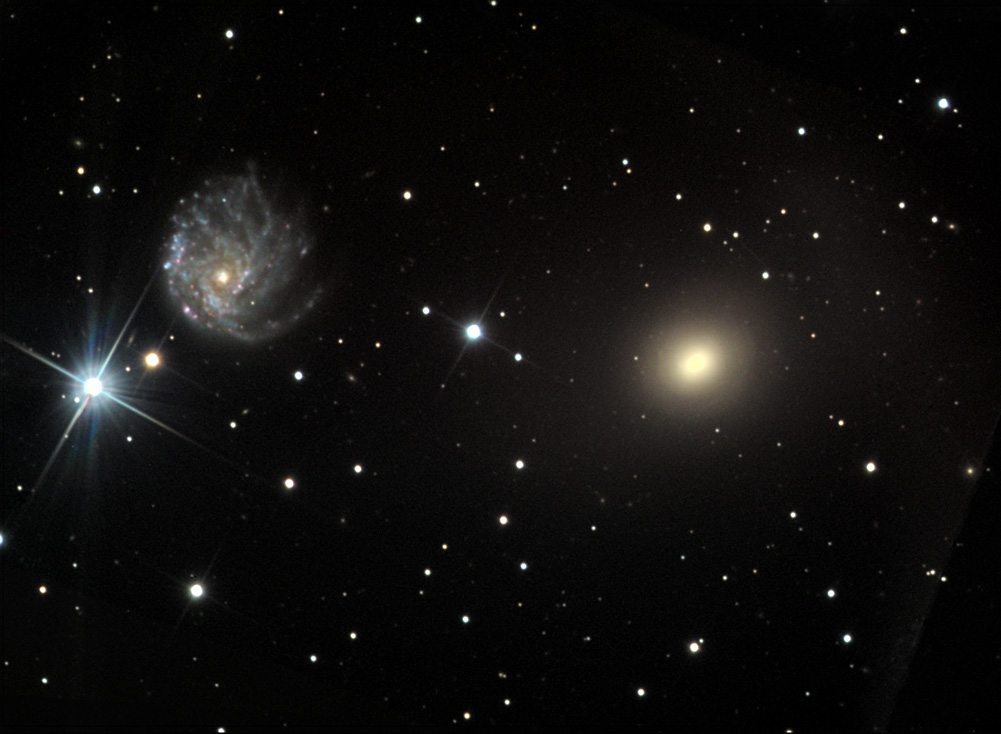luna-tick wrote:discussion on cartwheel galaxy is well presented. the cartwheel phenomenon being on the right and the two other galaxies appearing on left of screen. the discussion was important because it established nomenclature of reference on computer screen - the object on the right and the object on the left of a computer screen. i really did have a problem working out what is left and right on the computer screen. thank you for making that clarification.
the cartwheel galaxy.
image of the cartwheel galaxy.
discussion says that the cartwheel galaxy (on the right) and the two objects on the left are distinctly separate.
is there any possibility that the cartwheel galaxy and the two objects on the left are one and the same ??
and related by a before and after event ??
how could four objects - two yellow and two blue - appear so similar to each other and be so placed that they appear as neighbors in a cosmic portrait.
the convenient thing to do is to accept the explanation that the cartwheel galaxy and the two objects on left are physically separate bodies.
because the possibility of them being one and the same defies explanation.
You didn't get a lot of response to your question, so I'll chime in with some thoughts.
Yes, the galaxies are separate entities. They are separate in that their constituent stars are in orbit around the centers of the three different galaxies. The stars of the Cartwheel galaxy are in orbit around the center of mass of the Cartwheel galaxy, the stars of the small blue galaxy are in orbit around the center of the small blue galaxy, and the stars of the small yellow galaxy are in orbit around the center of the small yellow galaxy.
Mostly! Because it is possible that the galaxies have exchanged some stars, when they passed very close to each other. It is also possible that some of the stars have been flung into extremely elongated orbits when the galaxies passed close to one another.
We may also assume that the galaxies have dark matter halos that are in contact with one another, if the galaxies are located sufficiently close to one another.
A post that Art (neufer) made in this thread shows that the Cartwheel galaxy and the small blue galaxy seem to be connected by a stream of hot, X-ray emitting gas. So in a sense, the galaxies are connected. But the optical outlines of the galaxies are very clearly separated, which means that the stars of these two galaxies are in orbit around the centers of each separate galaxy.
NGC 2276 and NGC 3200.
Photo: Carlos and Crystal Acosta/Adam Block/NOAO/AURA/NSF
Finally, how can the two small galaxies next to the Cartwheel galaxy look so different (and be so different)?
I can only say that galaxies that are located close to one another sometimes look completely different. A prime example is the the spiral galaxy NGC 2276 and the elliptical galaxy NGC 2300. How can these two galaxies be so close together, yet have evolved so differently?
One possibility is that they were not born close together, but have gradually approached one another. If so, during the time when they were too widely separated to influence one another, they may have had very different "life histories". For example, the elliptical galaxy is likely to have undergone multiple collisions with smaller galaxies, which were then incorporated into the main body of NGC 2300. This may have messed up the spiral pattern of NGC 2300 and destroyed it. At the same time, multiple collisions may have fed the central black hole of NGC 2300, which may have heated and stirred up the gas of NGC 2300, making it unfit for star formation.
But NGC 2276 may have evolved slowly, undergoing few or no mergers and hanging on to most of its gas. When NGC 2276 then approached NGC 2300, the tidal forces acting on NGC 2276 compressed its gas and made it ripe for star formation.
What I'm suggesting is that the two small galaxies next to the Cartwheel galaxy may not have been born close to one another, so they may have evolved quite differently. But another possibility is that the small blue galaxy is undergoing a galaxy-wide burst of star formation due to its close interaction with the Cartwheel galaxy. Perhaps the small blue galaxy picked up a lot of gas from the Cartwheel somehow, and at the same time (or soon afterwards) this gas was compressed into perfect star forming conditions. The small yellow galaxy may be entirely devoid of gas. It looks like it.
Ann
 The Cartwheel Galaxy from Hubble
The Cartwheel Galaxy from Hubble
